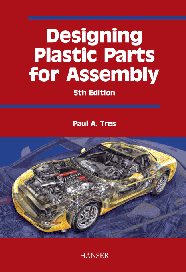Designing Plastics Parts for Assembly
|
Preface to 5th Edition Joerg-Uwe Szipl, Esq., President, February 2003 Washington, D.C.
|
It is a pleasure to preface Paul Tres' latest edition of his seminal work Designing Plastics Parts for Assembly. The enduring popularity of this work is due not only to Mr. Tres' thorough exposition of his subject matter, but its extreme ease of reference and lucid prose. A well–written treatise in any technical field is welcome, but one in the design and manufacture of plastics parts is essential for today ' s manufacturing economy, where plastics parts are assuming roles once thought impossible for man–made materials. The fact that this book is now in its Fifth Edition speaks for the usefulness of a text that clearly presents the basic principles of plastics parts manufacturing and design and then illustrates these principles with timely and well-conceived case histories. The case histories draw directly from Mr. Tres' extensive experience as a top consultant in the field of plastics for a Who's Who list of multinational clients. In these comprehensive illustrations, Tres applies the basic principles introduced by his reference book to cutting edge subjects such as press fittings, living hinges and snap fittings, essential to the palette of any parts designer. It is in these case histories that Mr. Tres' gift as a teacher and as a designer shines through. The result is a work that lends itself to the classroom, as a classic reference and as an aid to the practicing design engineer. The clear exposition and organization of Paul Tres' book makes it immediately useful to both the accomplished expert and the novice layman. I have used the book in preparation for complex patent litigation on matters related to the manufacture of plastic parts. In my experience, the simple organization and helpful illustrations made the book an ideal choice for explaining complex technical issues related to the manufacture and design of plastics parts to a lay jury. Likewise, the book lends itself to any application in which complex issues of plastic manufacture and design need to be concisely and accurately conveyed. In addition, the book is not short of intellectual rigor and lends itself equally well as a reference text for the accomplished technician and academician. Recommending the text is an easy task for me, but my introduction is superfluous, since the text speaks for itself.
|

